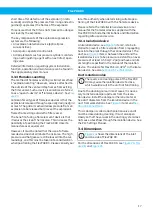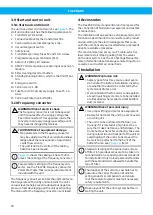
FlexPAK DX
Fill in the installation protocol during install-
Chapter 9 Appendix A: Installation
5.1 Delivery check
Check the unit for any transport damage. In case of
damage or missing parts, notify the carrier and your
local Nederman representative immediately.
5.2 Installation requirements
Prepare the location where FlexPAK DX is to be placed
before installation. Consider the following when in-
stalling the unit:
• The unit is to be anchored to a hard, level and firm
foundation. There are four fastening brackets on
the bottom frame to be used to fasten the unit to
the raised foundation.
• The total weight of the unit with accessories.
• Traction forces generated by explosion relief vent-
.
• Maximum weight of the collected material.
• Do not install the unit close to heat sources or hot
surfaces.
• Beware of hot air from the outlet.
• Ensure that handling is convenient.
• Ensure that emptying collected dust is convenient.
• Ensure that service and maintenance are conveni-
ent.
• In case of high relative humidity, do not expose the
unit to freezing temperatures.
• Do not place the unit in direct sunlight.
• Ensure that reverse airflow into the outlet is pre-
vented.
5.2.1 Bolts
Each of the anchor bolts securing the unit is to with-
stand traction forces of 6,5 kN vertically and 2,5 kN
.
Recommended bolts for concrete are Hilti HDA-PF 20-
M10×100/20. If expansion bolts are to be used, the
concrete foundation is to be prepared according to
bolt recommendations.
5.3 Duct dimensions and installation
shows the unit installed in a typical vacuum
duct system.
5.3.1 Requirements
Place a sign with the intended use of the vacuum sys-
tem on every user interface (workstation). Inform all
personnel of the intended use of the system. Ensure
that personnel using the equipment do not collect
items that may cause ignition or blocking.
WARNING! Explosion risk
• The ducting is to be built with a plain steel
pipe. Plastic pipe, such as PVC, is not to be
used. Almost all types of dust pick up stat-
ic electricity when sucked through a plastic
pipe, which significantly increases the risk for
an explosion if the dust is combustible.
• Do not collect material that may cause igni-
tion or blocking. It is strictly prohibited to col-
lect material that may undergo dangerous
chemical or thermal reactions and/or self-ig-
nite.
• Some types of dust may cause a dust explo-
sion and/or fire. Before installation, investig-
ate whether the dust to be collected by the
system constitutes a risk.
• The silencer outlet for exhaust air is to be dir-
ected upwards. Fit a Spiro duct to direct the
exhaust into the atmosphere. The duct is to
be routed to prevent any particles from fall-
ing into the unit, which could cause serious
damage
• Self-ignition can occur with some types of
dust. Under no circumstances may magnesi-
um and titanium dust be sucked into the sys-
tem.
All connected ducts are to be conductive and
grounded.
5.3.2 Recommendations
Transport velocity
It is important to use the correct duct diameter to
avoid pressure losses and dust deposits in the duct
system. Ensure that the correct transport velocity is
achieved. Correct velocity depends on the properties
of the transported material. Some applications may
require velocities up to 25 m/s (82 ft/s). Take velocity
into account when choosing duct diameters. The ve-
locity is never to decrease on the way to the unit. The
transport velocity in the ducts may vary depending on
how much of the vacuum system is used.
Flushing
Depending on the type of dust and fumes to be
filtered by the unit, a principle called flushing may be
used to keep the vacuum ducts clean. Flushing may
be applied by fitting a valve at the end of the duct sys-
tem. By not using the rest of the system, and open-
ing the so-called flush valve, a high amount of air will
flush the ducts clean. By flushing each branch of the
vacuum system separately, the risk of dust deposits is
minimized.
In larger vacuum systems with multiple units installed,
the installation of Duct Isolation Valves (DIV) is recom-
mended in order to isolate one unit for maintenance
while the others remain in normal operation.
21
Содержание FlexPAK DX
Страница 7: ...FlexPAK DX A E E A B C D G F 3A J I H 45 3B 7 ...
Страница 8: ...FlexPAK DX 13 12 10 9 7 8 2 1 3 4 6 5 11 4A 11 7 8 9 12 13 15 14 17 16 10 18 4B 8 ...
Страница 10: ...FlexPAK DX 6 A B 7 10 ...
Страница 13: ...FlexPAK DX 11 12 13 14 13 ...
Страница 14: ...FlexPAK DX A A A A C Min 2 1m 83 15 1 0 m 39 4 16 A B C 17 14 ...
Страница 36: ...www nederman com ...






































